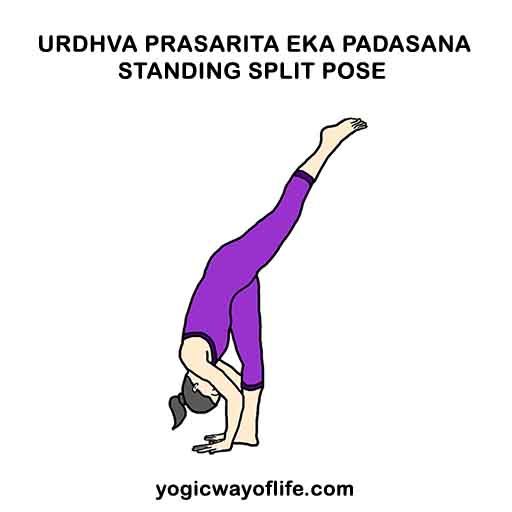Urdhva Prasarita Eka Padasana or the Standing Split pose stretches the back muscles, hamstrings, groin and leg muscles and improves body balance. In Sanskrit, Urdhva means upward, Prasarita means spread out, Eka means one, Pada means leg and Asana means a yoga posture. Urdhva Prasarita Eka Padasana is an intermediate to advanced level pose, which also gives benefits similar to other inverted poses.
How to do Urdhva Prasarita Eka Padasana (Standing Split Pose)
- Start in the standing position.
- Lift your left leg backwards in the air.
- Exhale slowly and bend forward and try to place your hands on the floor next to the right foot. Touch the floor and balance with your fingertips with each hand on either side of the right foot.
- Now bend slightly more and shift your weight onto the right leg. At the same time try to raise the left leg over the head. Keep the left leg straight. Do not bend the knees.
- Bring your hands as close to the right foot as possible so that the torso is brought as close to the right leg as possible.
- There is a variation where you can even hold the right leg (near ankles) with your right hand. This will help you to bring the chest as close to the right leg as possible. Do not strain. Only go as far as you can without any difficulty or pain.
- Breathe normally and maintain this position for as long as you are comfortable.
- To release the pose, bring the left leg down and simultaneously bring the two hands to rest in front of you. Raise the head and come back to the standing position.
- This can be repeated with the left leg placed on the floor and raising the right leg above the head.
Benefits of Urdhva Prasarita Eka Padasana (Standing Split Pose)
- Urdhva Prasarita Eka Padasana or Standing Split pose improves the sense of body balance and coordination.
- It gives some of the benefits of inverted asanas. It can help in mild headaches, migraines, mild depression and anxiety.
- Urdhva Prasarita Eka Padasana tones the organs in the abdomen.
- It stretches and strengthens the hamstrings, the calf, the thigh, the groins and the hip muscles.
- It strengthens the spine.
- This pose is a balancing pose. Staying in this posture for up to a minute improves the sense of body balance. It raises the level of confidence and awareness, as it requires quite a bit of focus to maintain the posture.
Contraindications of Urdhva Prasarita Eka Padasana
- Do this pose if you suffer from high blood pressure. All the dos and don’ts of inverted asanas are also valid for this pose.
- If you have any back or spine injury, avoid this pose completely. Also don’t do it if you have any shoulder or neck injury or problem.
- If you have any ankle or knee injury, do not do this pose.
- Urdhva Prasarita Eka Padasana should be done under supervision for those having vertigo problems.

